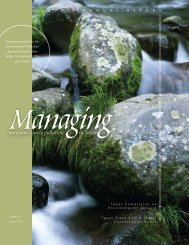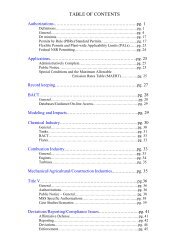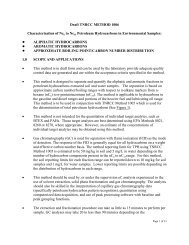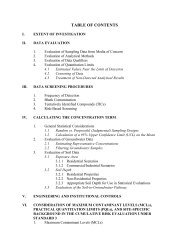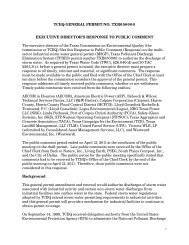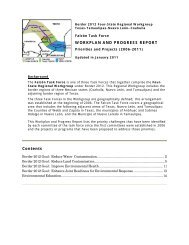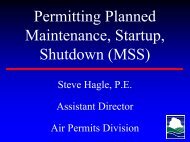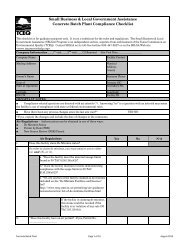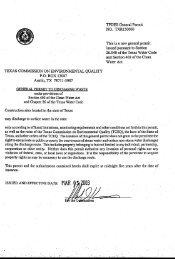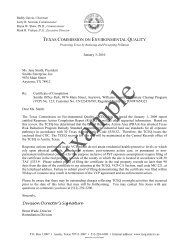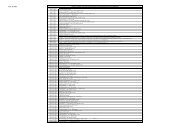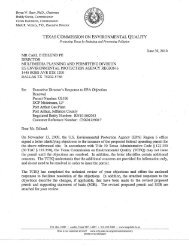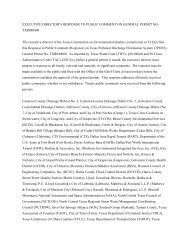Joint Groundwater Monitoring and ... - TCEQ e-Services
Joint Groundwater Monitoring and ... - TCEQ e-Services
Joint Groundwater Monitoring and ... - TCEQ e-Services
Create successful ePaper yourself
Turn your PDF publications into a flip-book with our unique Google optimized e-Paper software.
Public Water Supply Available. A public drinking water supply must be<br />
presently provided or could be provided to the proposed MSD property <strong>and</strong><br />
to properties within 0.5 miles of the MSD property.<br />
<strong>Groundwater</strong> Use Restriction. Potable use of groundwater within the proposed<br />
MSD must be restricted subject to an ordinance issued by the local municipality<br />
or subject to a restrictive covenant that is supported by a resolution passed by the<br />
local city council.<br />
As of the end of calendar year 2009, 118 MSD applications had been certified. The<br />
status of individual MSD applications can be monitored on the MSD web page.<br />
Maps of the MSD sites are also provided on the web page. Specific information on<br />
individual MSD applications can also be obtained from the status information.<br />
Railroad Commission of Texas Cleanup Fund Program<br />
The Site Remediation Section of the Railroad Commission of Texas (RCT) is<br />
responsible for the state-funded cleanup of ab<strong>and</strong>oned oil field pollution sites through<br />
the Oil-field Cleanup Program, which is described elsewhere in this report. With a<br />
combination of these programs, the remediation of groundwater contamination as a<br />
result of oil <strong>and</strong> gas exploration <strong>and</strong> production activities has become proactive to the<br />
point that historic pollution is diminishing <strong>and</strong> response to new releases is quicker<br />
<strong>and</strong> more effective.<br />
Cleanup options available for these sites include:<br />
<br />
<br />
<br />
cleanup to background constituent levels;<br />
cleanup to conservative risk-based levels (for example, TRRP Tier 1, Texas<br />
Surface Water Quality St<strong>and</strong>ards, Federal Drinking Water St<strong>and</strong>ards, <strong>and</strong> EPA<br />
Soil Screening Criteria); <strong>and</strong><br />
risk-assessment-driven cleanup using site-specific consideration <strong>and</strong> data.<br />
Regardless of ultimate closure options, when groundwater is contaminated, freephase<br />
hydrocarbons are expected to be removed, <strong>and</strong> full delineation of<br />
contamination in all directions is to be performed. For the purpose of establishing<br />
consistency, the RCT staff may use as guidance the TRRP groundwater resource<br />
classification system. This system is based on the Texas <strong>Groundwater</strong> Protection<br />
Committee’s classification (Appendix 3), with an additional consideration of lowyielding<br />
formations from which windmill pumps are able to provide water for stock.<br />
<strong>Groundwater</strong> Contamination<br />
The definition of groundwater contamination adopted by the TGPC (Title 31, Texas<br />
Administrative Code, §601.3) for use in this report is given in Appendix 4, Texas<br />
<strong>Groundwater</strong> Protection Committee Rules, <strong>and</strong> is paraphrased as follows:<br />
<strong>Groundwater</strong> Contamination - The detrimental alteration of the naturally<br />
occurring physical, thermal, chemical, or biological quality of groundwater.<br />
Further, groundwater contamination, for purposes of inclusion of cases in the<br />
public files <strong>and</strong> the joint groundwater monitoring <strong>and</strong> contamination report,<br />
shall be limited to contamination reasonably suspected of having been caused<br />
23



